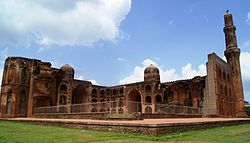List of monuments in Bidar
| SL. No. | Description | Location | Address | District | Coordinates | Image |
|---|---|---|---|---|---|---|
| N-KA-D37 | Bahmani Tombs | Astoor | Bidar | 17°54′55″N77°33′41″E / 17.91514°N 77.56143°E |  More images | |
| N-KA-D38 | Barid Shahi tombs | Bidar | Bidar | 17°55′12″N77°30′12″E / 17.91987°N 77.5033°E |  More images | |
| N-KA-D39 | Bidar Fort | Bidar | Bidar | 17°55′16″N77°31′52″E / 17.92107°N 77.53113°E |  More images | |
| N-KA-D40 | Madarsa Mahmud Gawan | Bidar | Bidar | 17°54′53″N77°31′49″E / 17.91486°N 77.53039°E |  More images |